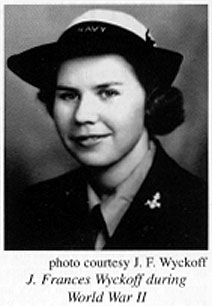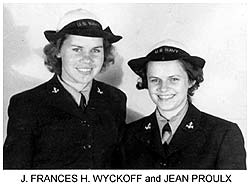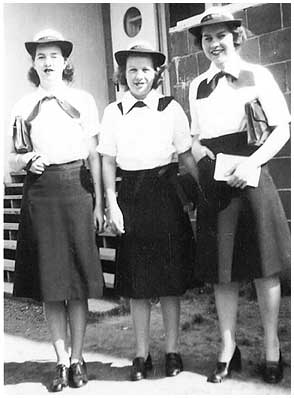 [This article appeared in the Fall 2006 edition of the NCVA CRYPTOLOG and is reproduced here with permission from Bob Payne, CRYPTOLOG editor.] A WAVE IN OP-20-GZ DURING WORLD WAR IIby J. Frances WyckoffEditor's Note: An earlier version of Frances Wyckoff's story was published in the May 2006 issue of World War II Magazine. I enlisted n the Navy in November 1942 and was accepted into the WAVES (Women Accepted for Volunteer Emergency Service) and ordered to report to Oklahoma A&M College in Stillwater for basic training. Apprehensive but eager, I readily took to military life. There were classes, marching, drilling and getting fitted for our uniforms. Apart from the military training, I attended many clerical classes and wondered what my future in uniform would hold. After 63 days at Stillwater and graduation, I was given a six-day leave and told to report to WAVE Quarters B in Washington, D.D. My war was not to be one of combat heroism or being sent to far distant shores. I would be stationed relatively close to my home, and at no time would I be placed in any great danger. After reporting for duty in Washington D.C., I joined a small group of other WAVES who were kept busy solving word puzzles. While we pondered what all of this meant, thinking we were simply killing time, our superiors were performing background checks on us and the Navy was making finishing touches to WAVE Quarters D, which would be our new home. Finally, a group of us were called together. The Espionage Act was read to us, and we took an oath to keep secret at all cost whatever we experienced in our next assignment.
I will never forget the first time I entered the large room where I would spend most of my service. There were six officers and three civilian translators, their desks lining each side of the room. In the middle was an eight-foot long, waist-high table that held huge code books. No one even looked up when I entered the room. Each person was bent over a desk working on text. There was just one other WAVE in GZ, and after breaking me into the new job, she was sent along to another assignment. When I was not typing on a special keyboard that was part of the decryption process, much of my time was spent in quarters. What had begun as a few buildings at the start of the war had, by the middle of 1943, expanded to include some 28 barracks. I was given a bunk in Barracks I, which was convenient to the mess hall and administration building. Double bunked, there were 83 other women on my floor alone.
We had many memorable experiences, including seeing the president and first lady and taking part in the funeral of Secretary of the Navy Frank Knox. Other memories are visiting the U.S.O. ice skating in the Chevy Chase Ice Palace, meeting other WAVES who tried to teach me to pronounce my "r's" and the summer heat of Washing D.C., especially before they allowed us to remove our suit jackets. Colors and Marching as a platoon in Oklahoma to the beat of a drum, movies at the Earl Theatre in D.C., Church services in the chapel at 3801 Nebraska Ave. I remember the good food at our cafeteria at WAVE Quarters D. In my fond memories are the war songs we listened to, the jukebox at the Hot Shoppe. People's Drugstore, the March of Dimes, the Hit Parade on the radio Saturday nights. V-Mail, receiving my gallon club pin from the Blood Bank, looking forward to a 48 or a 72 hour liberty, feeling homesick on Christmas Eve and last but not least, the day Peace was declared. Then a number of years later, going as a group to the farewell ceremony at the Security Group Headquarters which was transferring to Fort Meade, Maryland. The nature of our work meant that I never learned as much as I would have liked about my co-workers in GZ. Another factor preventing closer association was that our officers, although not supposed to go into a combat zone for fear of their being captured., did perform alternate duty. When one group left for sea duty, they would be replaced by another group of code-breakers. I knew it was important to keep what we did secret, but I longed to learn more about the people who worked in our office. I often studied the quiet, composed features of our civilian cryptologist Dorothy Edgers, who worked at the desk next to mine. She was so serious about her work, it was only slowly that I realized that behind her reserved exterior was an extroverted person. I enjoyed it when we could have lunch together and the time she invited a small group of us to her home. Even after these occasions and many hours spent in close proximity. I still learned very little about her role in breaking the Japanese codes and had no idea of her importance just prior to the attack on Pearl Harbor. It was only after the war that I discovered she had translated a message on 6 December 1941, that warned of a Japanese attack on Honolulu, and when she reported it to her superior at the time, Alwin Kramer, he told her simply, "Go Home." Edgers' brother, Fred Woodrough, worked in our office as well and had been there on 6 December. In late 1944, when congressional hearings were first held on the Pearl Harbor attack, Woodrough would testify, buy Edgers would not be allowed to. Despite what must have been an obvious disappointment, she never discussed this incident with me. Some of the officers I worked with had sort of an aloof superiority or mystery about them, which I would learn was typical of folks who worked in this branch of the Navy. From time to time, however, their more human side would come out. Mason, for example, was not only a brilliant cryptologist but also played a lively game of tennis on the courts behind our top-secret annex. Another, a Commander Fullinwider, would sometimes show me little gifts he had bought his wife. One of those purchases was a small musical powder box that played "Anchors Aweigh". Despite the isolation and secrecy, I enjoyed the work. By the end of 1944 there were approximately 83,000 WAVES, more that 17,000 of them in the Washington, D.C. area alone. They served as radio operators, storekeepers and yeomen. There were, by now, petty officer schools for aviation instrument mechanics, aviation gunnery specialists, cooks, bakers, hospital corpsmen and pigeon trainers, to name just a few. Although the role of women in the Navy had grown tremendously, there were still only a handful with a position like mine. Even now I remember wearing my pink GZ badge, which gave me access anywhere within the naval communications annex, with a great deal of pride. In February 1945, Mason returned from his tour of duty in Hawaii, and we were glad to have him with us again. On his first day back, we were visited by Read Admiral Joseph R. Redman, the aggressive director of naval communications, who was reputedly never afraid to stick his neck out. We learned that he kept a doghouse in his outer office. It was a real doghouse and inside usually stood a toy Scotty dog. If someone on Redman's staff blundered, the person's name was inscribed on a plaque and that plaque was hung on the front of the doghouse. Although unorthodox, his method of discipline was most effective. With the war nearing its conclusion, my schedule lightened somewhat and I was able to enjoy a few more activities, such as reading and, on 16 June, the wedding of LTJG Patricia Lockridge and Captain Gil Richardson, who both worked in our office. It was a very impressive ceremony at the National Cathedral and Mason and four of our other commanders were ushers. That summer, I celebrated the Fourth of July by watching the fireworks and on the 29th helped scour my barracks for an open house marking the WAVES third anniversary. On 7 August 1945 we received word of the atomic blast at Hiroshima, and shortly thereafter Nagasaki. We all waited to hear if this would finally mean the end of hostilities. Those of us in the cryptologist's office wondered if we would be first to get the news that millions had been waiting to hear. On the 12th, a false statement came over the radio that the war had ended, which set off a impromptu celebration, but finally, on 14 August 1945, it was official. The war was over. "I'm so excited I can hardly write," I said in my diary. The waiting was so hard. First they said the official announcement would be made at 0800 hours. Then it was 0900. Finally, by mid afternoon, we heard the great news. As soon as I could, I went out to enjoy the celebrations. I made it back to my room by midnight to write down what I had seen while it was still fresh: "I just came back from the downtown where everyone was yelling, ringing bells, dragging tin cans. Cars zig-zagged dizzily and it was obvious many revelers had been drinking. We were at Lafayette Park at 2145 where the biggest noise was. We proceeded down Pennsylvania Avenue and down F Street where we stopped to go inside St. Patrick's. We joined the crowds again then decided to go home. It took almost two hours to get away from the crowds. Downtown streets and sidewalks were jam-packed. It was so good to get home and listen to the rest of it on the radio." I reported for duty the next day, but everyone in my office was allowed to go home before noon. We were so grateful. "Peace" was printed in large letters on the front page of every paper. With the war over, I knew my time in uniform would be coming to an end and took advantage of every opportunity to sightsee. I was finally discharged in New York in December 1945. It was a three-day process, and the ceremony itself was very short. I went back to Washington and stayed for several weeks. Sad to see my time in the service at an end, I wore my uniform with the "ruptured duck" insignia for as long as I could. While deciding what to do, what to do, I took the civil service exam which led to a job with the Veterans Administration in my hometown of Boston. I married the boy I had been waiting for and a year later was blessed with a son. Three other children would follow, and my life as a mother soon separated me from my service days. I had taken the vow of secrecy seriously, and soon my service in OP-20_GZ and what little Japanese I had learned typing code numbers on a special typewriter and being addressed as "Harmonsan" was all by forgotten. It was only in the late 1980's that I was able to re-acquaint myself with some of the folks I had worked with during the war. While we could remember few of the details of our work, the reunion brought back many other fond memories. It also caused me to conclude that, of all the things I was or ever could have become, having been a WAVE and playing a small part in great events will always be the most important to me. As a result of Fran's Japanese Code-Breaking duties during WWII she received a letter from James Forestal and a "you never received this" Unit Commendation. |
 It was not until we were ordered to pack our bags and move to Quarters D on 18 May 1943 that I received my assignment. I would be working in OP-20-GY (Cryptanalysis and Decryption) at 3801 Nebraska Ave., directly across from my new home. I was at GY for only a few weeks before I was told to report to GZ, the Navy's top-secret translation section. The first thing I did was take another oath of secrecy, this one administered by a Commander Redfield Mason, who had headed up the effort to break the Japanese Magic and Purple codes. After my oath, I was reminded that every thing I would be involved with was hush-hush, so I was not to make any notes of what I did.
It was not until we were ordered to pack our bags and move to Quarters D on 18 May 1943 that I received my assignment. I would be working in OP-20-GY (Cryptanalysis and Decryption) at 3801 Nebraska Ave., directly across from my new home. I was at GY for only a few weeks before I was told to report to GZ, the Navy's top-secret translation section. The first thing I did was take another oath of secrecy, this one administered by a Commander Redfield Mason, who had headed up the effort to break the Japanese Magic and Purple codes. After my oath, I was reminded that every thing I would be involved with was hush-hush, so I was not to make any notes of what I did. I grew close to my barrack mates and maintained one of those friendships even to this day, that of Alvina Schwab Pettigrew. Another WAVE friend was Virginia Hritz Makerewicz. Others, no less dear to me, were Dorothy Burns whom I lost track of. Then there was Winnie Mercer, now living in Maryland, a member of NCVA, as is Alvina. Others I hear from are Norma Day, Jo Trotter, also an NCVA member, Gretchen Lynch Engelland and the late Dorothy Hughett Mears who with her husband drove all the way from Florida to see me about five years ago. And how could I forget Lucille Lux who had to leave the service in April of 1943. And Dorothy Short whose sister, known as The Black Dahlia was murdered in California.
I grew close to my barrack mates and maintained one of those friendships even to this day, that of Alvina Schwab Pettigrew. Another WAVE friend was Virginia Hritz Makerewicz. Others, no less dear to me, were Dorothy Burns whom I lost track of. Then there was Winnie Mercer, now living in Maryland, a member of NCVA, as is Alvina. Others I hear from are Norma Day, Jo Trotter, also an NCVA member, Gretchen Lynch Engelland and the late Dorothy Hughett Mears who with her husband drove all the way from Florida to see me about five years ago. And how could I forget Lucille Lux who had to leave the service in April of 1943. And Dorothy Short whose sister, known as The Black Dahlia was murdered in California.